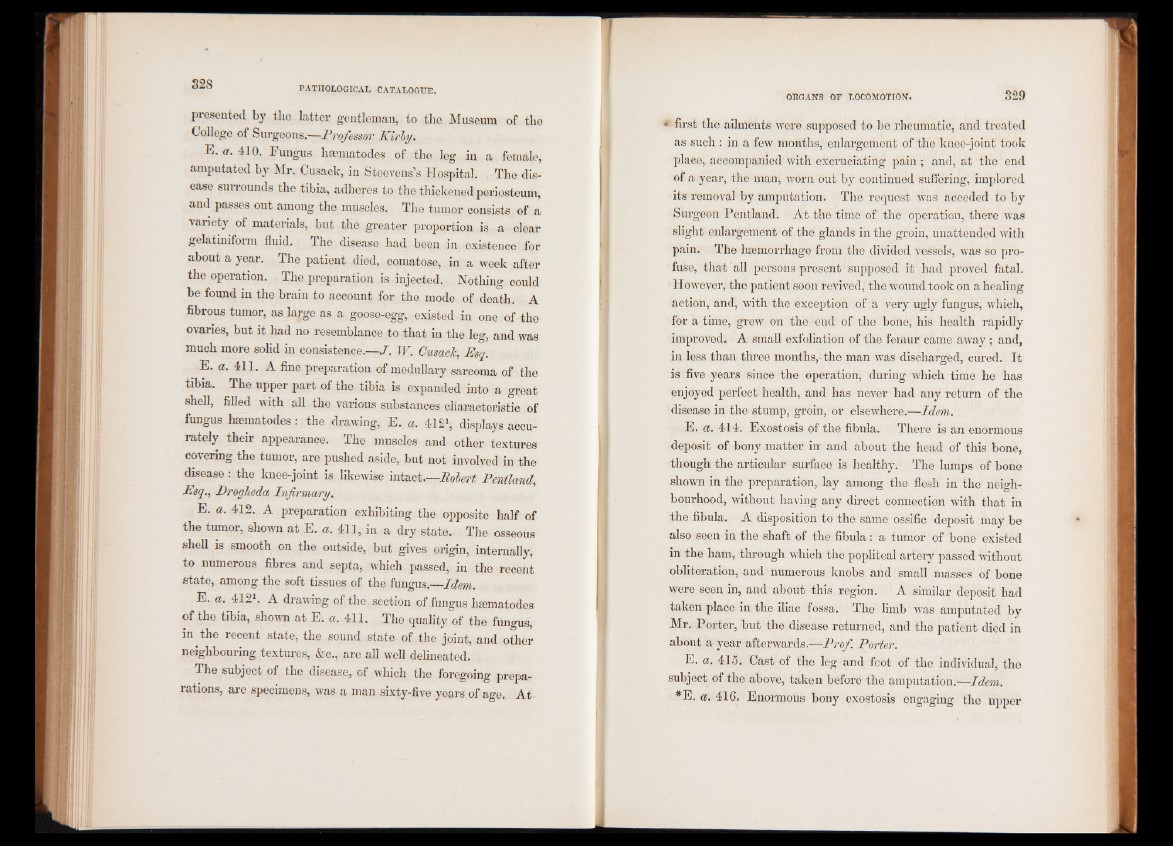
presented by the latter gentleman, to the Museum of the
College of Surgeons.—Professor Kirby.
E. a. 410. Fungus hsematodes of the leg in a female,
amputated by Mr. Cusack, in Steevens’s Hospital. The disease
surrounds the tibia, adheres to the thickened periosteum,
and passes out among the muscles. The tumor consists of a
variety of materials, but the greater proportion is a clear
gelatimform fluid. The disease had been in existence for
about a year. The patient died, comatose, in a week after
the operation. The preparation is injected. Nothing could
be found in the brain to account for the mode of death. A
fibrous tumor, as large as a goose-egg, existed in one of the
ovaries, but it had no resemblance to that in the leg, and was
much more solid in consistence.—J. W. Cusack, Esq.
E. a. 411. A fine preparation of medullary sarcoma of the
tibia. The upper part of the tibia is expanded into a great
shell, filled with all the various substances characteristic of
fungus hsematodes: the drawing, E. a. 4121, displays accurately
their appearance. The muscles and other textures
covering the tumor, are pushed aside, but not involved in the
disease : the knee-joint is likewise intact__Robert Pentland,
Esq., Drogheda Infirmary.
E. a. 412. A preparation exhibiting the opposite half of
the tumor, shown at E. a. 411, in a dry state. The osseous
shell is smooth on the outside, but gives origin, internally,
to numerous fibres and septa, which passed, in the recent
state, among the soft tissues of the fungus.—Idem.
E. a. 4121. A drawing of the section of fungus hsematodes
of the tibia, shown at E. a. 411. The quality of the fungus,
in the recent state, the sound state of the joint, and other
neighbouring textures, &c., are all well delineated.
The subject of the disease, of which the foregoing preparations,
are specimens, was a man sixty-five years of age. At
ORGANS OP LOCOMOTION. 329
* first the ailments were supposed to be rheumatic, and treated
as such : in a few months, enlargement of the knee-joint took
place, accompanied with excruciating pain; and, at the end
of a year, the man, worn out by continued suffering, implored
its removal by amputation. The request was acceded to by
Surgeon Pentland. At the time of the operation, there was
slight enlargement of the glands in the groin, unattended with
pain. The haemorrhage from the divided vessels, was so profuse,
that all persons present supposed it had proved fatal.
However, the patient soon revived, the wound took on a healing
action, and, with the exception of a very ugly fungus, which,
for a time, grew on the end of the bone, his health rapidly
improved. A small exfoliation of the femur came away; and,
in less than three months, the man was discharged, cured. It
is five years since the operation, during which time he has
enjoyed perfect health, and has never had any return of the
disease in the stump, groin, or elsewhere.—Idem.
E. a. 414. Exostosis of the fibula. There is an enormous
deposit of bony matter in and about the head of this bone,
though the articular surface is healthy. The lumps of bone
shown in the preparation, lay among the flesh in the neighbourhood,
without having any direct connection with that in
the fibula. A disposition to the same ossific deposit may be
also seen in the shaft of the fibula: a tumor of bone existed
in the ham, through which the popliteal artery passed without
obliteration, and numerous knobs and small masses of bone
were seen in, and about this region. A similar deposit had
taken place in the iliac fossa. The limb was amputated by
Mr. Porter, but the disease returned, and the patient died in
about a year afterwards.—Prof. Porter.
E. a. 415. Oast of the leg and foot of the individual, the
subject of the above, taken before the amputation.—Idem.
*E. a. 416. Enormous bony exostosis engaging the upper